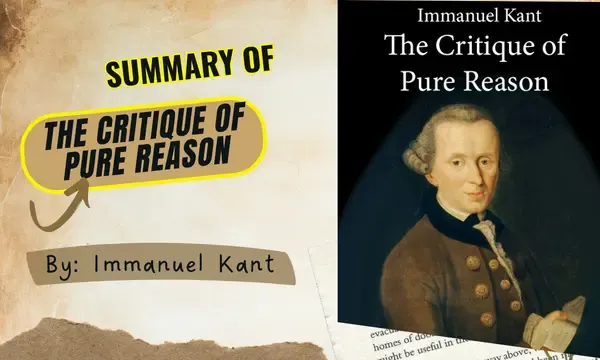The main topic of Immanuel Kant's The Critique of Pure Reason is epistemology and metaphysics, focusing on the limits and possibilities of human knowledge and the nature of reality.
 |
| Summary of the Critique of Pure Reason by Immanuel Kant |
The general idea of The Critique of Pure Reason
A priori knowledge: Kant argues that there are certain fundamental truths that are known independently of experience, which he calls a priori knowledge. These truths provide the necessary conditions for our experience and are rooted in the structure of the human mind.
Kant introduces the distinction between analytic and synthetic judgments: analytic judgments are true by definition and don't add new information, while synthetic judgments add new information to our understanding.
He also introduces the distinction between a priori and a posteriori knowledge: a priori knowledge is independent of experience, while a posteriori knowledge is based on empirical evidence.
Transcendental idealism: Kant proposes the concept of transcendental idealism, which suggests that while we can never know the things-in-themselves (noumena), we can understand the world as it appears to us through our faculties of perception and understanding.
The limits of reason: Kant argues that there are limits to what human reason can know. He claims that we can never know the ultimate nature of reality or answer certain metaphysical questions, such as the existence of God or the immortality of the soul.
About the author of The Critique of Pure Reason
Immanuel Kant (1724-1804) was a prominent German philosopher of the Enlightenment era. He is widely regarded as one of the most influential figures in Western philosophy. Kant's background in mathematics, physics, and philosophy contributed to his development of the critical philosophy, which sought to reconcile rationalism and empiricism.
Read more:
Summary of Beyond Good and Evil by Friedrich Nietzsche
Summary of Meditations on First Philosophy by René Descartes
Chapters of The Critique of Pure Reason
- Transcendental Aesthetic: In this section, Kant examines the nature of space and time, arguing that they are not inherent features of the external world but rather forms of intuition through which we perceive the world.
- Transcendental Logic: Kant explores the nature of understanding and judgment, introducing the distinction between analytic and synthetic judgments and explaining how concepts and categories play a role in our cognition.
- Transcendental Analytic: This section delves deeper into the categories of understanding and their application to the objects of experience. Kant distinguishes between phenomena (appearances) and noumena (things-in-themselves), emphasizing that we can only have knowledge of phenomena.
- Transcendental Dialectic: Kant discusses the limitations of reason when it comes to metaphysical questions, exposing the errors that arise when reason exceeds its rightful boundaries.
- Transcendental Doctrine of Method: In the final section, Kant outlines the proper method for pursuing philosophical inquiry, emphasizing the importance of systematic and critical thinking.
Conclusions of The Critique of Pure Reason
- Human knowledge is limited by the structure of our minds, and there are certain truths that we can know a priori, independent of experience.
- The world as we perceive it is shaped by our faculties of intuition and understanding, and we can never know the things-in-themselves.
- Reason has its limits, and we cannot provide definitive answers to certain metaphysical questions.
The Critique of Pure Reason book in relation to other books.
Compared to Descartes' Meditations on First Philosophy, which focuses on foundationalism and skepticism, Kant's Critique of Pure Reason provides a more comprehensive framework for understanding the limits and possibilities of human knowledge.
In contrast to David Hume's skepticism, Kant aims to establish the possibility of synthetic a priori knowledge, which Hume considered impossible.
Audience of The Critique of Pure Reason
The Critique of Pure Reason is primarily aimed at scholars, philosophers, and intellectuals interested in epistemology, metaphysics, and the limits of human knowledge. It requires a certain level of philosophical background and familiarity with previous philosophical works.
Date of publication of The Critique of Pure Reason
The Critique of Pure Reason was published in 1781 by Johann Friedrich Hartknoch in Riga, and a revised edition was released in 1787.
Recommendations for other books
If you are interested in exploring further on the subject, consider reading the following books:
- Prolegomena to Any Future Metaphysics by Immanuel Kant: A shorter work that serves as a useful introduction to the ideas presented in the Critique of Pure Reason.
- Phenomenology of Spirit by Georg Wilhelm Friedrich Hegel: An influential work that offers a different perspective on epistemology and metaphysics, engaging with Kant's ideas.
- An Enquiry Concerning Human Understanding by David Hume: Provides a contrasting viewpoint to Kant's philosophy, emphasizing empiricism and skepticism.

